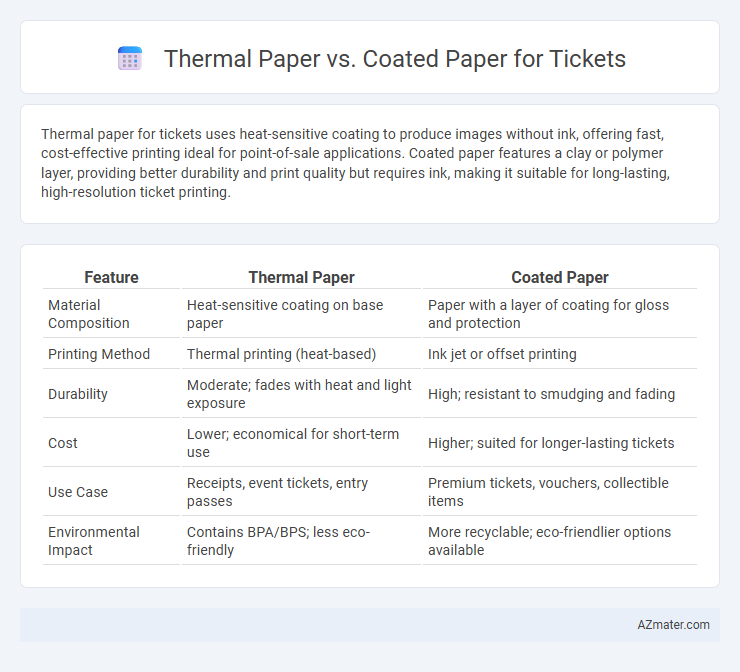Thermal paper for tickets uses heat-sensitive coating to produce images without ink, offering fast, cost-effective printing ideal for point-of-sale applications. Coated paper features a clay or polymer layer, providing better durability and print quality but requires ink, making it suitable for long-lasting, high-resolution ticket printing.
Table of Comparison
| Feature | Thermal Paper | Coated Paper |
|---|---|---|
| Material Composition | Heat-sensitive coating on base paper | Paper with a layer of coating for gloss and protection |
| Printing Method | Thermal printing (heat-based) | Ink jet or offset printing |
| Durability | Moderate; fades with heat and light exposure | High; resistant to smudging and fading |
| Cost | Lower; economical for short-term use | Higher; suited for longer-lasting tickets |
| Use Case | Receipts, event tickets, entry passes | Premium tickets, vouchers, collectible items |
| Environmental Impact | Contains BPA/BPS; less eco-friendly | More recyclable; eco-friendlier options available |
Introduction to Ticket Printing Materials
Thermal paper and coated paper are two primary materials used in ticket printing, each with distinct characteristics impacting print quality and durability. Thermal paper is heat-sensitive and commonly used in thermal printers for fast, high-contrast prints without ink or toner, ideal for receipts and event tickets requiring quick production. Coated paper features a smooth, treated surface suitable for inkjet or laser printing, offering vibrant colors and enhanced durability for tickets needing longer-lasting, detailed graphics.
What is Thermal Paper?
Thermal paper is a specially coated paper that changes color when exposed to heat, commonly used in receipt and ticket printing without the need for ink. Its heat-sensitive layer contains chemicals that react to thermal printheads, producing clear, fast, and high-resolution images. Compared to coated paper, thermal paper offers durability against smudging and is more efficient for high-volume, low-cost ticket printing applications.
What is Coated Paper?
Coated paper is regular paper treated with a surface coating of materials such as clay or latex to enhance brightness, smoothness, and print quality, making it ideal for high-resolution graphics and text on tickets. Unlike thermal paper, which changes color with heat, coated paper requires traditional ink-based printing methods, offering durability and resistance to smudging. This makes coated paper a preferred choice for tickets that need vibrant colors and long-lasting readability in various environments.
Printing Technologies: Direct Thermal vs. Conventional
Thermal paper uses a heat-sensitive coating that reacts to direct thermal printers, creating images without ink, optimizing efficiency and reducing maintenance costs in ticket printing. Coated paper requires conventional printing methods such as inkjet or laser, enabling vibrant colors and high-resolution images but increasing consumable expenses and print time. Direct thermal technology suits short-term ticketing with fast, economical prints, while conventional printing on coated paper offers durability and visual quality for longer-lasting tickets.
Durability and Lifespan of Printed Tickets
Thermal paper offers moderate durability with a lifespan of printed tickets typically ranging from 5 to 7 years under ideal storage conditions, but it is highly sensitive to heat, light, and moisture which can cause rapid fading. Coated paper, on the other hand, provides enhanced durability through a protective coating that resists abrasion, moisture, and UV exposure, significantly extending the lifespan of printed tickets up to 10 years or more. For long-term ticket preservation and resistance to environmental factors, coated paper outperforms thermal paper in maintaining print clarity and structural integrity.
Cost Comparison: Thermal vs. Coated Paper
Thermal paper generally costs less than coated paper due to its simpler manufacturing process and reduced ink usage, making it more economical for high-volume ticket printing. Coated paper requires additional treatments and inks, increasing production expenses and overall ticket cost. For businesses prioritizing cost-efficiency in ticket printing, thermal paper offers significant savings without compromising print quality.
Print Quality and Aesthetics
Thermal paper offers superior print quality for tickets with sharp, clear images and text due to its heat-sensitive coating, eliminating the need for ink and ensuring consistent, smudge-free prints. Coated paper, while providing a smoother surface and vibrant color reproduction through ink absorption, may experience ink smudging and fading over time, impacting long-term aesthetics. Ticket prints on thermal paper maintain durability and readability under various lighting conditions, enhancing both functionality and visual appeal for event or transit tickets.
Environmental Impact and Sustainability
Thermal paper often contains chemical coatings like BPA or BPS, which pose environmental hazards and complicate recycling processes compared to coated paper that generally uses safer, water-based coatings. Coated paper tickets, while requiring more energy for production due to additional layers, tend to be more recyclable and biodegradable, enhancing sustainability efforts. Selecting coated paper over thermal paper reduces harmful chemical waste and facilitates eco-friendly disposal, aligning better with environmental sustainability goals.
Use Cases: When to Choose Each Paper Type
Thermal paper is ideal for short-term use cases such as receipts, event tickets, and parking stubs where fast printing and cost-efficiency are crucial, especially in retail and hospitality environments. Coated paper is preferred for applications requiring durability and longer-lasting print quality, like museum passes, transportation tickets, or promotional vouchers exposed to frequent handling and environmental factors. Selecting thermal paper suits high-speed, low-cost printing needs, while coated paper ensures enhanced resilience and print clarity for extended use.
Conclusion: Which Paper is Best for Ticket Printing?
Thermal paper is ideal for ticket printing due to its cost-effectiveness, fast print speeds, and the ability to produce clear, smudge-resistant images without the need for ink. Coated paper offers higher durability and better print quality for color or graphic-heavy tickets but requires ink and slower processing. For most standard ticket printing applications, thermal paper outperforms coated paper in efficiency and long-term cost savings.

Infographic: Thermal paper vs Coated paper for Ticket
 azmater.com
azmater.com